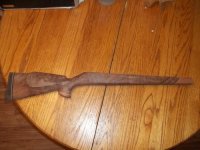Hunting rifle? or Target rifle?
Target I now use Helmsman Spar Urethane in the matt finish, last coats spray it on and stick it in an oven at 150 Deg. for 2 hours comes out hard as a rock, it will rival the two part auto finishes. I use a cardboard box, heat gun and a lead pot thermometer to regulate temp, real high tech. The matt finish comes out so slick it is hard to hang onto.
Helmsman Gloss is just the opposite, the surface has very good grip even after scuffing the shine off with steel wool.
I also cut the first coats with something to get it to soak in deep.
I have quit using all oil stock finishes unless matching something in that time period.
If you want something you can touch up easily after a season of use spray it with clear lacquer, 400 sand paper the scratch and blend, air brush the spot with some lacquer, 600 grit paper and rub it out with compound, would maybe take an hour to refurbish.
Just stuff I have done, in fact I still have a hunter in lacquer that was done in the early 90’s.
Rick



